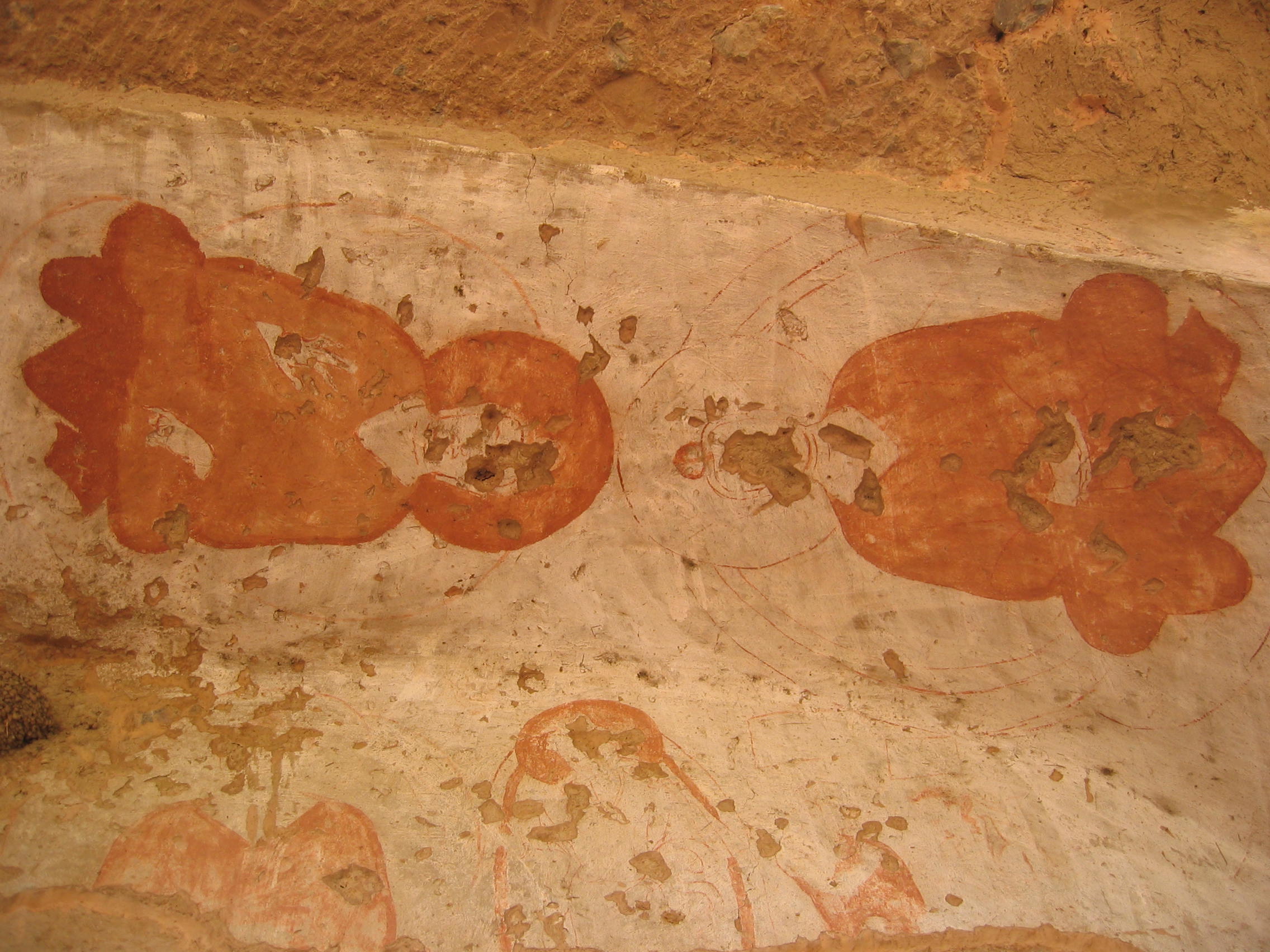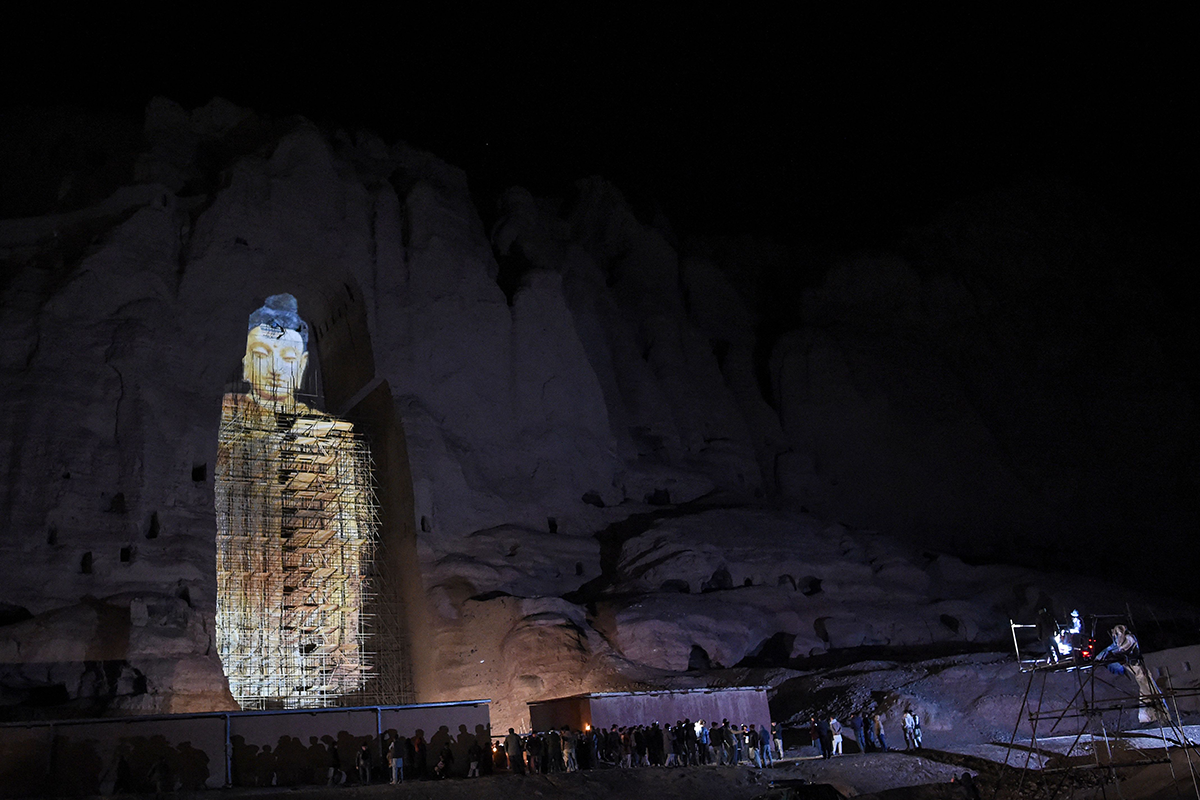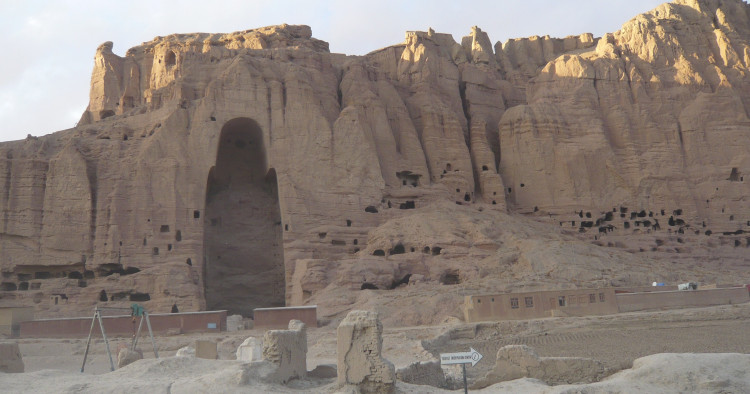As the world watches the Taliban takeover of Afghanistan and its aftermath, it’s like déjà vu all over again for the nation’s long-suffering peoples. With the Taliban back in the Bamiyan Valley, the UNESCO World Heritage site where Mullah Omar sanctioned the destruction of the 6th century Buddhas 20 years ago, we’ve seen this movie before and we know how it ends.
But for veteran UNESCO representative and archaeologist Mounir Bouchenaki, who tried and failed to negotiate with the Taliban to save the Buddhas in 2001, it’s a particularly poignant reminder that Afghanistan’s heritage — like its captive civilian population — is still at risk.
Bouchenaki, who was assistant director-general for culture at UNESCO in 2001 and is currently an advisor to UNESCO, the International Centre for the Study of the Preservation and Restoration of Cultural Property (ICCROM), and the Arab Regional Centre for World Heritage, says, “Obviously, with such a fluid situation on the ground, no one can predict exactly what the Taliban will do about cultural heritage.”
While it’s still early days, Bouchenaki, who was also in charge of protecting heritage in the wake of the 2003 invasion of Iraq, as well as in Kosovo from 2003-04, notes, “I am in contact with the director of the National Museum in Kabul (which was looted and vandalized by the Taliban in 2001), and I know that for the time being the collections are safe and protected."
The National Museum of Afghanistan posted on their Facebook page on Aug. 15 that “Staff, artifacts, and goods are safe,” but they also noted that “continuation of this chaotic situation causes a huge concern about the safety of the museum’s artifacts.” The statement urged that “security forces, the international community, Taliban, and other influential parties” should “not let opportunists use this situation.”
Director Fahim Rahimi said in an interview on Aug. 20 that the Taliban had posted guards outside the museum, but in a recent Facebook post added that, “For ensuring the safety of the collection, the museum will remain closed for a few days.”
A crossroads of civilizations
In spite of assurances from Taliban spokesman Suhail Shaheen on Aug. 16 that “Buddhist sites in Afghanistan are not at risk, I refute any claim in this regard,” since then, there have been reports of Taliban looting of a warehouse in the Bamiyan Valley. In addition to the empty niches that once held the world’s largest standing statues of the Buddha, the valley contains a wealth of other archeological artifacts, including a whole complex of caves, monasteries, and shrines, colorfully decorated by the monks who once meditated in them.

The area is also the heartland of the Hazaras, the Shi’a minority persecuted by the Taliban. According to local reports in Bamiyan, in mid-August Taliban fighters blew up a statue of Abdul Ali Mazari, a Hazara leader they executed in 1995.
Then came reports that the Taliban had occupied the Citadel in Herat’s old city, which is on the tentative World Heritage list along with other sites like the Musalla complex with the mausoleum of the empress consort Gawharshad and the Ghurid-era Friday Mosque. The citadel, which has been occupied over the centuries by many different forces and empires and destroyed and rebuilt several times, was most recently renovated by the Aga Khan Trust for Culture. One can only hope that the painstaking restoration will not be another casualty of the Taliban takeover.
Two weeks ago on Aug. 18, UNESCO Director-General Audrey Azoulay issued a statement calling “for the preservation of Afghanistan’s cultural heritage in its diversity, in full respect of international law, and for taking all necessary precautions to spare and protect cultural heritage from damage and looting.”
She also wrote of the nation that was a crossroads for Indian, Chinese, and European civilizations, “Afghanistan is home to a wide range of rich and diverse heritage, which is an integral part of Afghan history and identity, as well as of importance for humanity as a whole, that must be safeguarded.
And yet, as the U.N. has not recognized the new Taliban regime in Afghanistan, and as a third of the U.N. staff have now been moved to Kazakhstan, heritage experts wonder how the UNESCO edict will be enforced.
Trying to negotiate with the Taliban
While the U.S. government is now in communication with the Taliban, as Bouchenaki wrote in his book about his experience in Afghanistan, Patrimoines Mutilés, “In 2001, after Mullah Omar threatened to blow up the Buddhas just before Eid al-Adha (and said that “all statues and non-Islamic shrines in the different areas of the Islamic Emirate must be broken” because they were worshipped by people of non-Islamic religious beliefs and were therefore ‘idols.’), there were no formal channels open for negotiation with the Taliban. We couldn’t travel to meet them as we weren’t allowed to meet with a government not recognized by the U.N.”
Instead, he explains while on a visit to New York from his current bases in Bahrain and Paris, “We sent a special envoy to Kandahar.” That special envoy was none other than the former French ambassador to Pakistan, Pierre Lafrance, a skilled diplomat and linguist with an impressive knowledge of regional languages, cultures, and politics. While Lafrance was received by the Taliban’s minister of culture in Kandahar, Mullah Omar refused to see him. Lafrance then returned to Paris via Saudi Arabia — to see if he could negotiate with contacts there.
“We thought maybe the Taliban would want U.N. recognition,” explains Bouchenaki, “and that saving the Buddhas would be a way to facilitate that.”
Sadly, all efforts failed.
With the clock ticking — Mullah Omar’s announcement came on Feb. 27, 2001, and Eid al-Adha was to begin on March 5 that year — Bouchenaki and his colleagues spent a sleepless week devising a Plan B and C. Under the auspices of then-UNESCO Director-General Koïchiro Matsuura, a meeting of ambassadors from the 54 member states of the Organization of the Islamic Conference was held and all members adamantly protested the statues’ imminent demise. Even Pakistan, Saudi Arabia, and the UAE — the three countries that officially recognized the Taliban government — joined the protest, condemning the looming destruction of the Buddhas as “un-Islamic.”
When this effort failed to convince the Taliban, another idea was hatched. A delegation of 12 high-ranking Muslim leaders flew to Kandahar on a plane from Qatar on March 1, hoping to intervene. Unfortunately, Mullah Omar refused to receive them, says Bouchenaki, accusing them of being “American agents.”
Offers to transfer the statues to India, Japan, and even the Metropolitan Museum of Art were ignored, as were personal pleas from Kofi Annan, the Dalai Lama, Northern Alliance leader Ahmad Shah Massoud (whose son has now re-emerged as a political player), and even the former king of Afghanistan. In a rare press statement from his exile in Rome, Mohammed Zahir Shah said destruction of the Buddhas was "against the national and historic interests of the Afghan people."
With less than 24 hours before Eid al-Adha, Bouchenaki called the Pakistani minister of social affairs, Attiya Inayatullah, who was on the Executive Board of UNESCO. “I told her,” relates Bouchenaki, “‘We are faced with a terrible situation. Pakistan has links with the Taliban. Can you do something? Can you tell Mullah Omar that what he is doing will have serious consequences and will exacerbate tensions with Japan, India, Sri Lanka, Nepal, and many other nations with important Buddhist populations.’”
Through her intervention, the Pakistani minister of the interior went to Kandahar to plead UNESCO’s case to save the statues, but that effort was also unsuccessful.
“I felt my heart was breaking”
The next day, March 2, the Taliban began their gradual but brutal destruction of the ancient monuments, initially using dynamite.
Bouchenaki remembers watching the horrific spectacle on Al-Jazeera. “I felt my heart was breaking,” he recalls.
He was personally attacked in editorials in the French press at the time, he recounts, with pundits asking, “Why didn’t you go yourself in front of the Buddhas and demand their protection?”
In what could be likened to a more tragic version of “The Monuments Men” — albeit one directed by the French with a sadder, less Hollywood ending — the destruction was carried out in stages. After dynamiting the statues, the Taliban moved on to anti-aircraft guns and artillery, which caused significant damage but did not destroy them completely. At the time, Taliban Information Minister Qudratullah Jamal complained, "This work of destruction is not as simple as people might think. You can't knock down the statues by shelling as both are carved into a cliff; they are firmly attached to the mountain."
“It was precedent setting in the Muslim world,” notes Bouchenaki of the demise of the Buddhas, which survived even the Mongol invasion, “to have such an act of obliteration.”
During the barbaric attacks on World Heritage Sites, which escalated to placing anti-tank mines at the bottom of the niches, as well as rockets directed at the face of the Buddhas, Mullah Omar said, "What are you complaining about? We are only waging war on stones.”
Afghanistan today
But now, after 40 years of conflict, it’s a war on Afghanistan’s young people and educated classes that form the fractured nation’s intangible heritage that concerns Bouchenaki. They are fleeing in their thousands and he is worried about what the resultant “brain drain” might mean for the future of the country.
And while the work of Bouchenaki and other heritage experts over the past two decades has left Afghanistan in a much stronger place in terms of preservation issues, he says that “illegal excavations and looting (an ongoing issue even after the U.S. invasion in 2001) pose a greater threat than the Taliban.” And so, he says, does the instability and chaos left in the wake of the U.S. withdrawal, recently exploited by ISIS’s local affiliate, Islamic State-Khorasan Province.
Bouchenaki notes an important difference between the Taliban, who “during their regime were more involved in destruction than trafficking of artifacts,” and ISIS in Iraq and Syria, who “had their own wing to deal with cultural heritage” — and often ended up selling what they didn’t blow up on the black market. But in the current security vacuum, he says, “anything could happen.”
Added to these security issues are ongoing preservation issues, such as soil erosion threatening the Minaret of Jam (on UNESCO’s endangered heritage list), whose environs also include a 12th century Jewish cemetery that speaks — in contrast to Talibani fundamentalism — to Afghanistan’s pluralist past. And years of corruption and mismanagement have led to neglect of many heritage sites.
Still, Bouchenaki says, “I hope that maybe the young generation is different. I hope that now we have a better understanding of preserving both Islamic and non-Islamic heritage, as part of our global patrimony.”
He also hopes that world leaders, whom he notes have been thus far somewhat silent on the matter, will prioritize heritage preservation.
Meanwhile, in the Bamiyan Valley, where the remnants of colorful murals rim the edges of the niches once filled by the Buddhas, the art works’ synthesis of Buddhist and Indian Gupta styles as well as Sasanian, Byzantine, and Turkic influences speak to Afghanistan’s rich Silk Road legacy. The empty niches, which have become ruined monuments to the excesses of extremism themselves, occasionally contain projected holograms of the obliterated Buddhas — both their absence and their phantom presence haunting the nation’s future.

Ironically, it was the destruction of the Buddhas that prompted further excavations, revealing 50 more caves including 12 with wall paintings. In the rubble of the statues, a team of international scientists also discovered the translation of the first section of the original Sanskrit Pratityasamutpada Sutra. Translated by the 7th century Chinese monk, Xuanzang, it articulates one of the core tenets of Buddhism: “All things are transient.”
While such subtleties may have been lost on the Taliban two decades ago, one can only hope that the world community will hold their latest iteration to account.
Hadani Ditmars is the author of Dancing in the No-Fly Zone: A Woman's Journey Through Iraq, a past editor at New Internationalist, and has been reporting from the Middle East on culture, society, and politics for two decades. Her book in progress, Between Two Rivers, is a political travelogue of ancient and sacred sites in Iraq. The views expressed in this piece are her own.
Main photo copyright by UNESCO under Creative Commons Attribution-ShareAlike 3.0 IGO
The Middle East Institute (MEI) is an independent, non-partisan, non-for-profit, educational organization. It does not engage in advocacy and its scholars’ opinions are their own. MEI welcomes financial donations, but retains sole editorial control over its work and its publications reflect only the authors’ views. For a listing of MEI donors, please click here.













